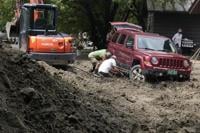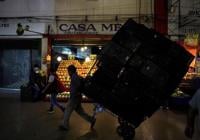RIO DE JANEIRO (AP) — It was once Latin America's largest landfill. Now, a decade after Rio de Janeiro shut it down and redoubled efforts to recover the surrounding expanse of highly polluted swamp, crabs, snails, fish and birds are once again populating the mangrove forest.
“If we didn't say this used to be a landfill, people would think it's a farm. The only thing missing is cattle,” jokes Elias Gouveia, an engineer with Comlurb, the city's garbage collection agency that is shepherding the plantation project. “This is an environmental lesson that we must learn from: nature is remarkable. If we don’t pollute nature, it heals itself.”
Gouveia, who has worked with Comlurb for 38 years, witnessed the Gramacho landfill recovery project's timid first steps in the late 1990s.
The former landfill is located right by the 148 square miles (383 square kilometers) Guanabara Bay. Between the landfill's inauguration in 1968 and 1996, some 80 million tons of garbage were dumped in the area, polluting the bay and surrounding rivers with trash and runoff.
In 1996, the city began implementing measures to limit the levels of pollution in the landfill, starting with treating some of the leachate, the toxic byproduct of mountains of rotting trash. But garbage continued to pile up until 2012, when the city finally shut it down.
“When I got there, the mangrove was almost completely devastated, due to the leachate, which had been released for a long time, and the garbage that arrived from Guanabara Bay,” recalled Mario Moscatelli, a biologist hired by the city in 1997 to assist officials in the ambitious undertaking.
The bay was once home to a thriving artisanal fishing industry and popular palm-lined beaches. But it has since become and two commercial ports. At low tide, household trash, including old washing machines and soggy couches, float atop vast islands of accumulated sewage and sediment.
The landfill, where mountains of trash once attracted hundreds of pickers, was gradually covered with clay. Comlurb employees started removing garbage, building a rainwater drainage system, and replanting mangroves, an ecosystem that has proven particularly resilient — and successful — in similar environmental recovery projects.
Mangroves are of particular interest for environmental restoration for their capacity to capture and store large amounts of planet-warming carbon dioxide, Gouveia explained.
Experts say mangroves can bury even more carbon in the sediment than a tropical rainforest, .
To help preserve the rejuvenated mangrove from the trash coming from nearby communities, where residents sometimes throw garbage into the rivers, the city used clay from the swamp to build a network of fences. To this day, Comlurb employees continue to maintain and strengthen the fences, which are regularly damaged by trespassers looking for crabs.
Leachate still leaks from the now-covered landfill, which Comlurb is collecting and treating in one of its wastewater stations.
Comlurb and its private partner, Statled Brasil, have successfully recovered some 60 hectares, an area six times bigger than what they started with in the late 1990s.
“We have turned things around," Gouveia said. "Before, (the landfill) was polluting the bay and the rivers. Now, it is the bay and the rivers that are polluting us.”










































